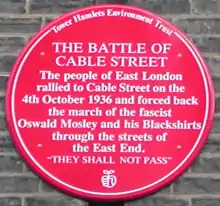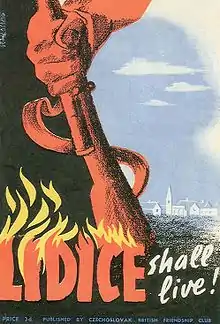Lou Kenton
Lou Kenton (1 September 1908 – 17 September 2012) was an English proofreader who served as a medical courier and ambulance driver with the International Brigade and was its oldest surviving member at the time of his death.
Lou Kenton | |
|---|---|
| Born | 1 September 1908 Stepney, London, England |
| Died | 17 September 2012 (aged 104) West Acton, London, England |
| Nationality | British |
| Occupation | soldier, seaman, proofreader |
| Known for | opposition to the British Union of Fascists; service in the International Brigades |
| Spouse(s) | 1. Lillian (divorced) 2. Raffa Ephgrave (married 1941) |
Early life

Kenton was born in Stepney, east London to a Jewish Ukrainian family who had escaped from Tsarist pogroms.[1] His father died from tuberculosis when he was young.
Kenton left school aged 14 and started work in a paper factory. There he first encountered anti-semitism, which led him to join the Communist Party of Great Britain in 1929. He took part in the CPGB's disruption of the British Union of Fascists' rally at Olympia in June 1934 and resistance to the BUF in the Battle of Cable Street in October 1936.[2]
Spain
Early in 1937 Kenton left Stepney and rode his Douglas motorcycle to Albacete, where he join the International Brigades in the Spanish Civil War. His first wife Lillian, an Austrian nurse who fled Nazi Germany in 1933, shortly followed him. When he arrived at the International Brigades headquarters in Albacete, he applied to join the International Brigade's Medical Unit. It was from there that he spent nearly two years in action as medical courier on his motorcycle distributing medical supplies to hospitals across the country, and as an ambulance driver on the front lines. He returned to Britain late in 1938 on an 'Aid for Spain' mission to raise money for a new ambulance. By the time he had completed his tour, the International Brigades had been disbanded.
Later life
After the International Brigades were withdrawn from Spain, Kenton was hugely depressed.[3] One of his missions was to repatriate to the Spanish authorities the Basque refugees given asylum in the United Kingdom. It was "the first time I saw the fascist police in their three-cornered hats. All the children were in tears and all of them were hanging on to me as we checked each one and handed them over."[2]

Kenton then joined the Merchant Navy and in the first part of the Second World War served on an Antarctic whaler, the Southern Princess. He and Lillian were divorced and in 1941 Kenton married his second wife Raffa Ephgrave. He was wounded in The Blitz, spent two years in hospital and then took a factory job.[2] After the Lidice massacre in Czechoslovakia in 1942, Kenton joined the British "Lidice Shall Live" organisation. He was an active member for many years and in the 1990s served as its Chairman.
After the Second World War, Kenton joined the Homes for Heroes campaign, which helped homeless ex-servicemen and their families to squat in unoccupied properties. He joined the Financial Times as a proofreader, and continued to work there until he was in his 70s.[2]
Kenton remained a devout communist, working tirelessly on trade union organisation, unemployed marches and party activities until 1968 when the Prague Spring was suppressed by the Soviet Union. He then joined the Labour Party and remained a member for the rest of his life.
Commemorative potter
From 1980 Kenton produced commemorative pottery for the trade union movement and for radical causes. His work was commissioned by Associated Society of Locomotive Engineers and Firemen, Tobacco Workers' Union, Society of Graphical and Allied Trades, Trades Union Congress, areas of the National Union of Mineworkers, the People's March for Jobs, the International Brigade, Greater London Council Peace Year, National Council for Civil Liberties, Campaign for Nuclear Disarmament, and the Greenham Common women's campaign.
Kenton had two children and two granddaughters.
References
- Arthur, Max (2009). "Section 1 – Lou Kenton". The Real Band of Brothers – First hand accounts from the last British survivors of the Spanish Civil War. London: HarperCollins. p. 21. ISBN 9780007295098. – reference to Kenton's place and date of birth
- "Lou Kenton". The Daily Telegraph. Telegraph Media Group. 20 September 2012. Retrieved 4 October 2016.
- Baxell, Richard (2012). "21, From Spanish War to World War". Unlikely Warriors: The British in the Spanish Civil War and the Struggle Against Fascism. London: Aurum Press. p. 409. ISBN 9781781312339. – reference to Kenton's depression following the Republic's defeat
- Haynes, Deborah. "Spanish Civil War volunteers are granted citizenship 70 years on". The Times.(subscription required)
- "Spain Honours Foreign Veterans Of The Spanish Civil War (Lou Kenton)". Zimbio.
- "Spain Honours Foreign Veterans Of The Spanish Civil War (Lou Kenton)". Zimbio.
External links
- Jones, Sam (9 June 2009). "Spain remembers: war veterans honoured". The Guardian. (includes video)
- Katz, Ian (10 November 2000). "'I shall never forget it, as long as I live'". The Guardian. Guardian Media Group.
- Routledge, Paul (4 February 1996). "Spain repays its debt of blood and honour". The Independent.
- Sugarman, Martin, Against Fascism – Jews Who Served in The Spanish Civil War (PDF), Jewish Virtual Library
- "Kenton, Louis (Oral history)". Imperial War Museums.
- "International Brigade: 70 Years On. London July 15, 2006". Indymedia UK.
- "¡Hemos llegado a casa!" (PDF). IBMT Newsletter (nine). International Brigade Memorial Trust. September 2004. pp. 4–5.
- "Spanish Civil War: English and Irish International Brigade veterans honoured with citizenship". Daily Mirror. Trinity Mirror. 1 June 2009.
- "Lou Kenton". The Daily Telegraph. Telegraph Media Group. 20 September 2012.
- "Band of brothers: Seventy years ago, these British volunteers risked their lives to fight fascism. Why has their heroism been overlooked until now?". The Times.(subscription required) (Start of seven-page article that includes a profile of Kenton)